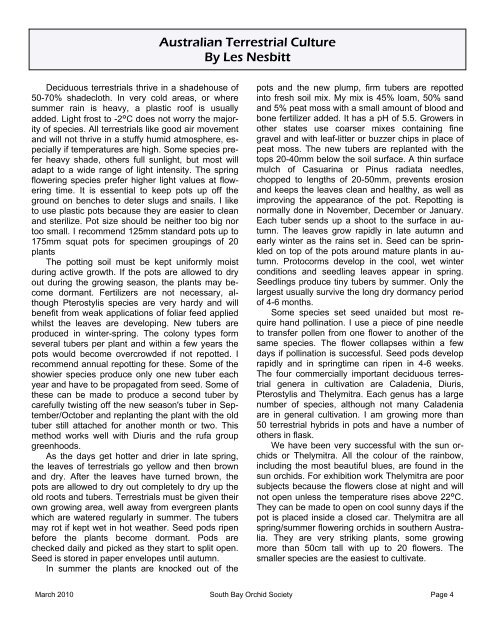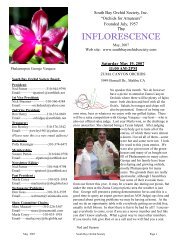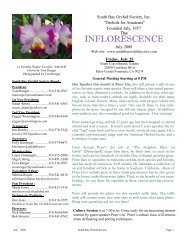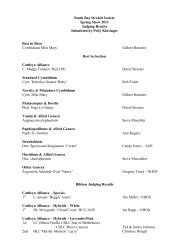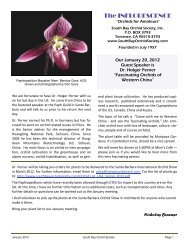March 2010 - South Bay Orchid Society
March 2010 - South Bay Orchid Society
March 2010 - South Bay Orchid Society
Create successful ePaper yourself
Turn your PDF publications into a flip-book with our unique Google optimized e-Paper software.
Australian Terrestrial Culture<br />
By Les Nesbitt<br />
Deciduous terrestrials thrive in a shadehouse of<br />
50-70% shadecloth. In very cold areas, or where<br />
summer rain is heavy, a plastic roof is usually<br />
added. Light frost to -2°C does not worry the majority<br />
of species. All terrestrials like good air movement<br />
and will not thrive in a stuffy humid atmosphere, especially<br />
if temperatures are high. Some species prefer<br />
heavy shade, others full sunlight, but most will<br />
adapt to a wide range of light intensity. The spring<br />
flowering species prefer higher light values at flowering<br />
time. It is essential to keep pots up off the<br />
ground on benches to deter slugs and snails. I like<br />
to use plastic pots because they are easier to clean<br />
and sterilize. Pot size should be neither too big nor<br />
too small. I recommend 125mm standard pots up to<br />
175mm squat pots for specimen groupings of 20<br />
plants<br />
The potting soil must be kept uniformly moist<br />
during active growth. If the pots are allowed to dry<br />
out during the growing season, the plants may become<br />
dormant. Fertilizers are not necessary, although<br />
Pterostylis species are very hardy and will<br />
benefit from weak applications of foliar feed applied<br />
whilst the leaves are developing. New tubers are<br />
produced in winter-spring. The colony types form<br />
several tubers per plant and within a few years the<br />
pots would become overcrowded if not repotted. I<br />
recommend annual repotting for these. Some of the<br />
showier species produce only one new tuber each<br />
year and have to be propagated from seed. Some of<br />
these can be made to produce a second tuber by<br />
carefully twisting off the new season's tuber in September/October<br />
and replanting the plant with the old<br />
tuber still attached for another month or two. This<br />
method works well with Diuris and the rufa group<br />
greenhoods.<br />
As the days get hotter and drier in late spring,<br />
the leaves of terrestrials go yellow and then brown<br />
and dry. After the leaves have turned brown, the<br />
pots are allowed to dry out completely to dry up the<br />
old roots and tubers. Terrestrials must be given their<br />
own growing area, well away from evergreen plants<br />
which are watered regularly in summer. The tubers<br />
may rot if kept wet in hot weather. Seed pods ripen<br />
before the plants become dormant. Pods are<br />
checked daily and picked as they start to split open.<br />
Seed is stored in paper envelopes until autumn.<br />
In summer the plants are knocked out of the<br />
pots and the new plump, firm tubers are repotted<br />
into fresh soil mix. My mix is 45% loam, 50% sand<br />
and 5% peat moss with a small amount of blood and<br />
bone fertilizer added. It has a pH of 5.5. Growers in<br />
other states use coarser mixes containing fine<br />
gravel and with leaf-litter or buzzer chips in place of<br />
peat moss. The new tubers are replanted with the<br />
tops 20-40mm below the soil surface. A thin surface<br />
mulch of Casuarina or Pinus radiata needles,<br />
chopped to lengths of 20-50mm, prevents erosion<br />
and keeps the leaves clean and healthy, as well as<br />
improving the appearance of the pot. Repotting is<br />
normally done in November, December or January.<br />
Each tuber sends up a shoot to the surface in autumn.<br />
The leaves grow rapidly in late autumn and<br />
early winter as the rains set in. Seed can be sprinkled<br />
on top of the pots around mature plants in autumn.<br />
Protocorms develop in the cool, wet winter<br />
conditions and seedling leaves appear in spring.<br />
Seedlings produce tiny tubers by summer. Only the<br />
largest usually survive the long dry dormancy period<br />
of 4-6 months.<br />
Some species set seed unaided but most require<br />
hand pollination. I use a piece of pine needle<br />
to transfer pollen from one flower to another of the<br />
same species. The flower collapses within a few<br />
days if pollination is successful. Seed pods develop<br />
rapidly and in springtime can ripen in 4-6 weeks.<br />
The four commercially important deciduous terrestrial<br />
genera in cultivation are Caladenia, Diuris,<br />
Pterostylis and Thelymitra. Each genus has a large<br />
number of species, although not many Caladenia<br />
are in general cultivation. I am growing more than<br />
50 terrestrial hybrids in pots and have a number of<br />
others in flask.<br />
We have been very successful with the sun orchids<br />
or Thelymitra. All the colour of the rainbow,<br />
including the most beautiful blues, are found in the<br />
sun orchids. For exhibition work Thelymitra are poor<br />
subjects because the flowers close at night and will<br />
not open unless the temperature rises above 22°C.<br />
They can be made to open on cool sunny days if the<br />
pot is placed inside a closed car. Thelymitra are all<br />
spring/summer flowering orchids in southern Australia.<br />
They are very striking plants, some growing<br />
more than 50cm tall with up to 20 flowers. The<br />
smaller species are the easiest to cultivate.<br />
<strong>March</strong> <strong>2010</strong> <strong>South</strong> <strong>Bay</strong> <strong>Orchid</strong> <strong>Society</strong> Page 4


